
![]()
Introduction
Versailles in pictures
This page is also available in French
![]()
Berlioz conducted a large-scale concert in the palace of Versailles not far from Paris, on Sunday 29 October 1848. It was in several respects a special occasion, born of exceptional circumstances in the wake of the revolution which had swept away the government of Louis-Philippe and replaced it with a short-lived republic. It came also at a difficult moment in Berlioz’s life: his father had died on 28 July not long after the composer’s return from his first trip to London, and Harriet Smithson’s health was deteriorating. Berlioz’s correspondence is the main source of information for the event, which receives only a passing allusion in the seventh evening of the Soirées de l’orchestre (in the second paragraph of the section entitled Madame Rosenhain); it is not mentioned in the Memoirs. On 12 October, writing to his sister Nancy about his busy timetable Berlioz mentions the forthcoming concert (Correspondance Générale no. 1227, hereafter CG for short; cf. also no. 1211):
[…] I have been asked to conduct a large concert which is to be given for the benefit of the fund of associated musicians; it will be in the hall of the great opera of the palace at Versailles, and all my time is now taken up with these preparations. […]
In her reply a few days later Nancy expressed the hope that the concert would bring some financial benefit to Berlioz (CG no. 1229, 17 October). This hope was not realised (see below the letters to Adèle and to Nancy).
The programme of the concert included overtures by Beethoven (Leonora no. 2, which Berlioz preferred to the more popular no. 3), Rossini (La Gazza Ladra or The Thieving Magpie), Mozart’s Ave Verum (a work much admired by Berlioz who cites it in full in his Treatise on Orchestration, in the chapter on Voices), a chorus and dances from Gluck’s Armide, and Weber’s Invitation to the Dance in Berlioz’s own popular orchestration. Berlioz’s music was represented by the song La Captive, sung by Mme Wiedemann and receiving only its second performance, and the first in its orchestral version (cf. CG no. 1880), the celebrated Hungarian March which he had written two years earlier for his visit to Budapest, and part II of Romeo and Juliet – the ball at the Capulets, one of his regular concert pieces. On 22 October, a week before the concert and as a preliminary to it, a Mass by Adolphe Adam was performed at the Chapel of Versailles palace under the direction of Georges Bousquet, for the benefit of the needy – an invitation to this Mass by the Association of Artist-Musicians is extant, bearing the signature of the president of the Association, Baron Taylor, and several notable composers and musicians, including Berlioz himself (see the reproduction of the original in D. Kern Holoman, Berlioz [1989], p. 406). On 24 October Berlioz wrote to Baron Taylor asking him to insert the text of the song La Captive in the programme that was to be distributed at the concert; he added that he was having the concert advertised in the Journal des Débats as well as in another paper (CG no. 1232, cf. CG III p. 582 n. 1).
The concert was a large-scale undertaking, with over 400 instrumentalists and singers taking part. Berlioz’s orchestration of the Invitation to the Dance includes two parts for harp; on this occasion they were performed by no less than 18 players. A letter of Berlioz in the run-up to the concert mentions the ‘legion’ of players he was taking with him from Paris to Versailles for the occasion (CG no. 1232bis [vol. VIII]). Two letters of 27 October, in which Berlioz sends complimentary tickets to friends, refer to a rehearsal which had taken place that same day: ‘It would give me great pleasure if you were able to come; I believe the concert will be rather good. This morning’s rehearsal encourages me to believe so’ (CG no. 1234, to an unknown correspondent); ‘I am so exhausted by this morning’s rehearsal that I can scarcely hold my pen’ (CG no. 1233, to Émile Deschamps). Deschamps was the author of the libretto of Romeo and Juliet and thus had a special connection with the work; letters of Berlioz in 1857 and 1858 show that at that time Deschamps actually had a domicile in Versailles (CG nos. 2257, 2258, 2282) though it is not known whether this was the case in 1848 (CG no. 1372 suggests so).
Three letters of Berlioz after the concert give his impressions of the occasion; they also illuminate the context, both personal and political, in which it took place. To his other sister Adèle on 1 November (CG no. 1236):
I have just spent three weeks in a state of excessive agitation and I am exhausted by exertions of every kind. Some 16 or 17 days ago Harriet suffered a stroke, which left her right side completely paralysed and has deprived her of speech. I had to go to Montmartre [where Harriet had returned that year] twice a day and the doctor did what he could to go there frequently as well. Repeated bleedings, applications of mustard poultice, and all the usual remedies in such cases, were to no avail. At last the day before yesterday she began to be able to speak a few words in English, but she is quite incapable of articulating even two words in French. The paralysis seems to be abating a little, but you can hardly take into account the very slight sensation which can be detected in the foot. At the same time the Committee of the Association of Musicians in Paris came to ask me to organise and direct a vast musical festival which was to take place at the palace of Versailles. You can imagine how preoccupied I was! This concert took place last Sunday [29 October] in that dazzling hall to which the public has only been admitted once before by Louis Philippe; the takings were huge and we had to turn back five hundred people. For the pieces of my own composition I scored a great success. But these festive occasions drain me completely, and cause me to waste a great deal of time without earning any money, since the receipts go to the Funds of the Society. Among the audience we had part of the government, including M. Marrast [the president of the National Assembly] who had demanded the royal seat. As a result the chair in the middle of the amphitheatre has now been occupied by 5 sovereigns: Louis XV, Louis XVI, Louis-Philippe I, Napoleon I, and Marrast 0!!!! […]
To his sister Nancy on 10 November (CG no. 1237):
[…] Your letter has been delivered. I had indeed assumed that Adèle would communicate to you what I wrote to her. Yes, this concert has been a very unwelcome burden and has made me dreadfully tired. Besides, the time it has caused me to waste what amounts to the loss of at least two hundred francs.
The presidency of the little fellow Marrast in the royal chair is causing a devil of a stir; he is bombarded with jeers about it from the entire press. In any case I believe his reign is over. Who is going to inherit the sceptre of the Republic? […]
Finally on 28 November to the Russian Count Mikhail Wielhorsky, whom he had met during his first trip to Russia in 1847 (CG no. 1240):
[…] Paris is still suffering from a fever and has frequent attacks of delirium tremens; to think of peaceful intellectual activity, to seek for beauty in literature and the arts in such a state of affairs, is like wanting to play a game of billiards on a storm-tossed ship at the Antarctic Pole when the ship’s hold has just sprung a leak and a mutiny of the sailors has broken out in the steerage.
And yet we recently organised a fine concert at Versailles for the fund of the association of musicians. I had been entrusted with the organisation and direction of this musical festival. We were provided with the magnificent hall in the Palace which the general public has only been able to see twice since it exists. The takings were magnificent, considering the times and climate we live in. The low price of the seats did not allow us to operate on a grand scale. We had the Illustrious Marrast surrounded with his crowd of rascals, sitting in the places and seats of Louis XV and his court. You have probably read in the newspapers about this republican buffoonery. […]
![]()
The pictures displayed below have been scanned from postcards and from the book Paris and Its Environs by Augustus Pugin and Charles Heath (1830), in our collection. The original engravings published in Paris and Its Environs were made in 1829. © Monir Tayeb and Michel Austin. All rights of reproduction reserved.
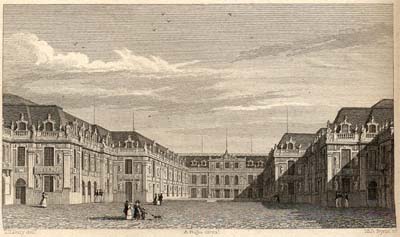
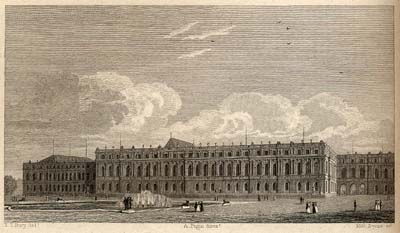
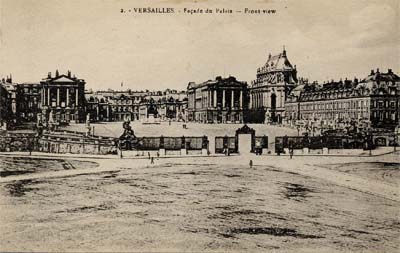
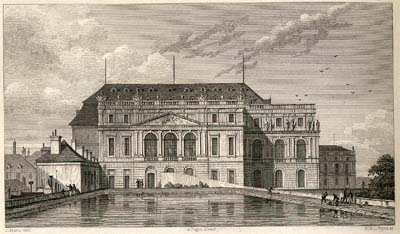
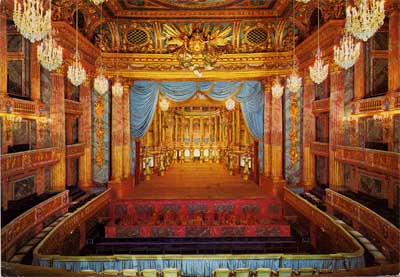
This card was posted in Bordeaux on 26 August 1984.
Built in 1869-1879 for Louis XV as the ‘Opéra Royal’ by the architect Ange-Jacques Gabriel, the opera was based on an existing 17th century building by François Mansart. It opened on 16 May 1770 with a performance of Lully’s Persée during the wedding festivities of Prince Louis (the future King Louis XIV) and the Austrian arch-duchess Marie-Antoinette. With 712 seats it was the largest theatre in France at the time of its opening. Closed during the French Revolution in 1789 it was revived and redecorated by Louis-Philippe in 1837. It was extensively restored in 1952-1957 to its original 1770 plans.
![]()
The Hector Berlioz Website was created by Monir Tayeb and Michel Austin on 18 July 1997;
Berlioz in Versailles page created on 20 May 2008. Revised on 1 September 2023.
© Monir Tayeb and Michel Austin for all the pictures and information on this page.
Copyright notice: The texts, photos, images and musical scores on all pages of this site are covered by UK Law and International Law. All rights of publication or reproduction of this material in any form, including Web page use, are reserved. Their use without our explicit permission is illegal.